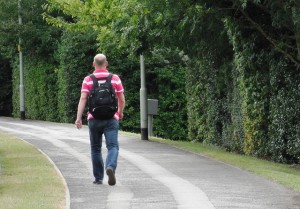 People start walking programs for a number of different reasons. You might be new to fitness and have your eyes set on running a 10K but need to start with walking. You might be a fitness buff who wants to include some variety to the program by including a couple of days of intense walking. Or, you might just be interested in a walking fitness program right now with no further goals. Any and all of these are legitimate reasons to incorporate walking into your daily regimens and through which you’ll experience some significant results.
People start walking programs for a number of different reasons. You might be new to fitness and have your eyes set on running a 10K but need to start with walking. You might be a fitness buff who wants to include some variety to the program by including a couple of days of intense walking. Or, you might just be interested in a walking fitness program right now with no further goals. Any and all of these are legitimate reasons to incorporate walking into your daily regimens and through which you’ll experience some significant results.
Walking is one of the best and easiest exercises to get started. For the most part, it’s free. By walking for 30 minutes a day you’ll live longer, burn calories, lose fat, reduce your risk of heart disease, cancer and diabetes and have more confidence. According to the National Heart, Lung and Blood Institute, staying active can help prevent or delay age-related health problems, at any age. (1)
It’s important, if you are just starting out, to start slow and easy. Although you might think that walking comes naturally, you’ll need to have comfortable and supportive shoes and comfortable, weather-appropriate clothing. You wouldn’t consider an intense walking program in high heels or men’s dress shoes or you’d soon be limping to the sidelines.
Once you have the basic equipment (shoes and clothes) you can start out by walking 20 minutes at a pace that quickens both your heart and breathing. You should still be able to talk and hold a conversation, but you aren’t out for a stroll . . . the goal is exercise.
When we walk through the mall, through the office or around the house we often fall into bad habits with our posture. Think about elongating your body and walking straight and tall. This will help to engage all the muscles in your body and relieve the stress in your upper back from sitting hunched over machinery or computers all day. Keep your shoulder blades down, which will also keep your shoulders back and your abs tight.
The National Heart Lung and Blood Institute developed a sample walking program that will take you through your first 12 weeks of walking and get your body ready for a variety of other programs that will help to burn fat faster or improve your cardiovascular fitness. (2)
Remember to start at a pace that is comfortable to hold a conversation but is faster than a stroll. Over time you’ll be able to pick up the pace and go with more intensity.
 Sometimes including a walking program into an already packed day can be a challenge. Here are some ways to include the walk without reducing your productivity:
Sometimes including a walking program into an already packed day can be a challenge. Here are some ways to include the walk without reducing your productivity:
- Walk during lunch at work. Order take out and walk to pick it up. Bring your lunch, eat it quickly and spend 20 minutes walking around the grounds outside or within the office building.
- Take the kids with you for a walk after work or school. They can ride bikes or be in the stroller. Have school work to do with them? Quiz them on their math and English facts on the walk.
- Get up 30 minutes early and go for a walk with neighborhood friends. Stay safe! Bring a flashlight and wear reflective clothing.
- Walk for 15 minutes at lunch and 15 minutes as soon as you get home. You’ll never miss those 2-15 minute time slots but your body will reap the rewards of the time you put in every day.
- Can’t get outside? Consider buying a treadmill for your home. They are much more affordable today and you may even be able to purchase a nice used one at a used sporting goods store, on Craig’s List or from a friend. Fire up the treadmill for 30 minutes in the morning or 30 minutes before dinner. You can walk and talk to your children, watch a show you’ve been missing or listen to books on tape.
- Aim for longer walks on the weekends. Go with friends or find a walking group interested in walking for an hour. You’ll burn up to 2x times the number of calories over the hour and keep the calorie burn going even after you’ve stopped.
Walking with intensity will increase the fat and calorie burn. Mix it up a little after you are well accustomed to the walking program.
Warm up for five minutes and then walk as fast as possible for a set amount of time, turn around and walk home slowing as you near the end point to cool down. Mark where you turn around at the end of the timed portion and see if you can get further and further each week.
High intensity workouts will burn more fat than moderate or low intensity programs. Work to keep your abs tight during the walk, your shoulders back and relaxed and your head tall.
Keep your walks interesting by changing the routine, the route and the music. Add a partner or two on some days and change the pace you walk to add variety. If you are walking without a watch you can vary your speed from one landmark to another – like light poles or mailboxes.
References:
(1) National Heart, Lung and Blood Institute: Your Guide to a Healthy Heart
http://www.nhlbi.nih.gov/health/public/heart/other/your_guide/healthyheart.pdf
(2) National Heart Lung and Blood Institute: Sample Walking Program
http://www.nhlbi.nih.gov/hbp/prevent/p_active/walk.htm
Resources:
The Walking Site: Beginning a Fitness Walking Program
http://www.thewalkingsite.com/beginner.html
American Heart Association: Worksite Wellness Kit
http://www.startwalkingnow.org/start_workplace_walking_program.jsp
Fitness Magazine: The Fat-Burning Walking Workout Plan
http://www.fitnessmagazine.com/workout/cardio/walking/fat-burning-walking-workout-plan/#page=1
Better Homes and Gardens: Easy 12 Week Walking Program
http://www.bhg.com/health-family/fitness/workouts-programs/easy-12-week-walking-program/#page=3
Hal Higdon: 10K Training Guide Walking Program
http://www.halhigdon.com/training/51125/10K-Walk-Training-Program
MayoClinic: Get Walking with this 12-Week Walking Schedule
http://www.mayoclinic.org/healthy-living/fitness/in-depth/walking/art-20050972
Prevention: 14 Walking Workouts to Burn Fat and Boost Energy
http://www.prevention.com/fitness/fitness-tips/?s=1


Leave a Reply